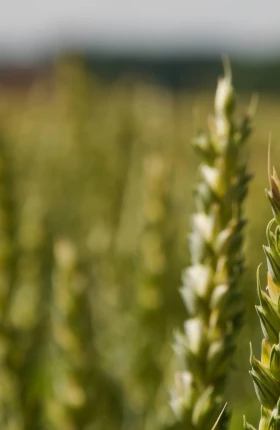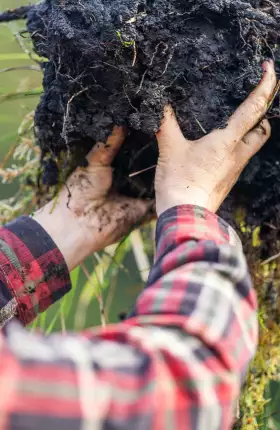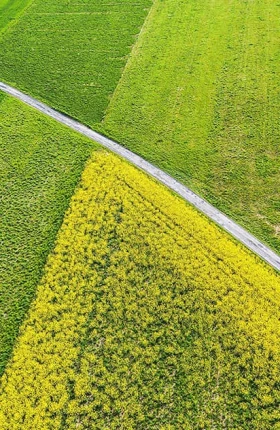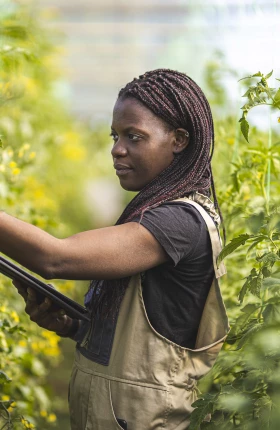Investing in regenerative agriculture and sustainable land management isn’t just for governments and NGOs. If the proper financing mechanisms, supportive government policies, and monitoring schemes are in place, commercial investors can play a major role—and gain an attractive return on investment.
Our global food system accounts for a third of greenhouse gas emissions, employs nearly 1.3 billion people, and provides essential nutrition for people across the planet, according to the UN’s Food and Agriculture Organization. Yet the Climate Policy Initiative estimates that only about 7% of climate finance goes toward making the food system more sustainable.
Stay ahead with BCG insights on climate change and sustainability
The cost of inaction is significant. Volatility in food supply chains is at an all-time high, and BCG forecasts that yields for key commodities such as wheat, corn, and rice could decline by 15% to 35% by 2050 if insufficient action is taken. Recent developments in the cocoa market showcase what’s at stake, as climate-related drought and disease contributed to major supply disruptions and a 400% surge in cocoa prices in 2024.
Regenerative agriculture offers a proven solution. It can increase yields and resilience to climate-related weather events, thus lowering costs and boosting farming profitability—all while restoring soil health, storing carbon, protecting biodiversity, and improving water management. When combined with sustainable land management practices such as ecosystem restoration and conservation into a broader landscape approach, the benefits are even greater. For too long, however, the private sector has viewed landscape regeneration as being the province of governments and philanthropies rather than constituting a mainstream investment class.
Although public and donor funding is essential, it can provide only part of the solution. Regeneration of the 30 most valuable landscapes around the world represents an asset class worth $310 billion and with the potential to generate an internal rate of return (IRR) of 15% to 30% over a ten-year period for commercial investors, including institutional asset managers, banks, and insurers.
The business case for investment in regenerative landscapes is strong. The challenge lies in bringing together a diverse set of financial instruments from across governments, catalytic investors, and commercial investors to form an integrated financing stack that can fund the long-term shift from fragmented pilot programs to large-scale, investable, market-ready systems.
Seizing the Opportunity
One key to unlocking the considerable investment potential of regenerative agriculture is to take a systems approach to regenerating entire food production landscapes at scale. (See the sidebar “Regeneration Across Landscapes.”) To that end, we have mapped the world’s 325 leading food-producing landscapes; analyzed them by the degree to which they are under stress from soil degradation, water pollution, land conversion, and biodiversity loss; and evaluated their potential for regeneration, increased yields, and carbon sequestration. (See the sidebar “The Global Landscape Explorer.”)
Regeneration Across Landscapes
Regenerative landscapes restore and enhance ecological systems while also supporting sustainable livelihoods. According to the Action Agenda on Regenerative Landscapes, this land management approach integrates regenerative production with ecosystem conservation and restoration. The approach aims to build resilience in ecosystems and communities alike through an outcome-based framework, noting that specific practices may differ, depending on context.
The Global Landscape Explorer
This analysis has enabled us to prioritize the 30 landscapes globally that have the greatest transition potential by 2030. (See the slideshow.) Our findings indicate that transitioning these landscapes alone could drive significant positive impact, reaching a third of global carbon sequestration potential from agriculture and delivering average increases of 15% in available soil water, 8% to 15% in soil organic matter, and 20% to 60% in above- and below-ground biodiversity. Furthermore, regenerating these landscapes would significantly curtail and in some places eliminate the economic rationale for deforesting new land for agricultural production.
The specific investment case and return profile for regenerative agriculture is highly localized, and varies by geography, commodity, and production system. Our models of the business case in a diverse set of landscapes indicate that investors funding the regenerative transition in these 30 highly valuable landscapes can expect an IRR of 15% to 30%, largely due to lower input costs and higher productivity. Assuming a 50/50 split of public and private funding and a 5x leverage ratio from catalytic capital, we estimate a $310 billion opportunity for commercial investors. Although this figure captures the investment opportunity at a highly generalized level, it highlights the material opportunity for financial return.
The regenerative landscape transition is already underway amid increasing awareness of its many benefits, and new financing pathways are emerging. Yet regenerative agriculture and sustainable land management remain severely undercapitalized. The reasons are both financial and structural:
- Fragmented and Subscale Financing Mechanisms. Transition finance is growing, but in many instances, funding mechanisms are not fit for purpose, and they lack blended finance that would provide a clear pathway to de-risking the transition and enabling commercial investments.
- Insufficient Policy Alignment. Often, regulatory frameworks and incentives contradict program objectives, and public funding can be fragmented or inaccessible. Many landscapes lack the legal foundation, including land registry documentation, that would allow investors to engage with producers in a secure and structured way.
- Lack of Consistent, Affordable Measurement Systems. Proliferating and frequently inconsistent standards create high reporting costs for farmers and limit stakeholders’ ability to measure and reward outcomes.
- Fragmented Partnerships. Many initiatives lack the right mix of financial, technical, and local stakeholders needed to reach scale. Coordination challenges tend to slow programs down and keep costs high.
The end result is a risk-reward profile that is inaccessible for commercial investors. Without sufficient investment, regenerative agriculture programs often remain stuck at the pilot stage, resulting in a weak pipeline of investable deals and limited evidence of success at scale. This, in turn, can limit investment appetite and reinforce a cycle of stagnation. But the situation is starting to change.
The Action Agenda on Regenerative Landscapes
The COP28 Action Agenda on Regenerative Landscapes (AARL) was launched in 2023 by the COP28 Presidency, the World Business Council for Sustainable Development (WBCSD), and BCG, with the support of the UN Climate High-Level Champions, to aggregate, accelerate, and amplify collective action and investment in regenerative agriculture and sustainable land management at the landscape level. The initiative unites more than 40 global participants that have collectively committed $9 billion, covering 210 million hectares and reaching 12 million farmers across more than 110 countries by 2030.
Key investors in the effort include agrifood companies looking to enhance the resilience of their supply chains and financiers interested in seizing the opportunity to generate real financial returns while benefiting from the positive environmental impact of regenerative agriculture.
To unlock investment into regenerative landscapes, three elements are essential:
- Integrated and blended financing structures that de-risk the transition by supporting farmers with the right incentives at the right time
- Aligned public policy frameworks that remove disincentives to the transition and promote the incentives and transparency needed to encourage farmers to act
- Efficient measurement, reporting, and verification systems that enable cost-effective collection and management of data by farmers, ensure interoperability between different data platforms and tools, and support the creation of transparent and trusted markets for regenerative commodities and the ecosystem services they provide.
The approach to achieving these three elements is inherently local. By recognizing that regeneration must happen at the landscape level, AARL’s work translates global commitments into place-based landscape programs that address all three elements necessary to unleash the commercial investment opportunity. The first of these programs, AARL’s Landscape Accelerator: Brazil (LAB)—a partnership of 15 major agrifood companies operating in Brazil co-chaired by BCG, WBCSD, and the Brazilian Business Council for Sustainable Development in partnership with Brazil’s Ministry of Agriculture—is already in progress in that country, in two biomes: the Amazon and the Cerrado. The Cerrrado’s unique agricultural circumstances offer a compelling example of the potential for regenerative transformation at scale.
Place-Based Acceleration in the Cerrado
Covering 200 million hectares, the Cerrado is the world’s most biodiverse savannah. It produces a quarter of the world’s soy and sugarcane, but agricultural progress has come at a steep cost. Deforestation and land conversion rates have surged by 71% in recent years, and a hotter and drier climate threatens to destabilize farming in the region.
Together, BCG and Brazil’s Ministry of Agriculture conducted an in-depth analysis of more than 1 million rural properties, integrating farm-level profit-and-loss data with geospatial analytics and a survey of 1,350 farmers. (See the sidebar “What Do Brazilian Farmers Think?”) The conclusion was clear: Brazil can expand agricultural output substantially without deforesting new land.
What Do Brazilian Farmers Think?
These findings informed AARL’s LAB, which aims to use regenerative techniques to convert 24 million hectares of degraded pastureland into newly viable pastureland and crops and to adopt regenerative agricultural methods on another 9 million hectares of cropland. (See Exhibit 1.) The result is an investment opportunity worth a total of $55 billion and offering an average IRR of 19%.

Seizing the investment opportunity calls for taking a blended finance approach that brings together multiple types of financing instruments with varying return profiles to absorb early-stage risks, build the proof points necessary to crowd in commercial capital at scale, and provide farmers with the right type of financial support at the right time. The financing stack consists of three distinct types of capital: catalytic capital that invests at a lower rate of return; direct unqualified support to farmers; and commercial capital that can be unlocked as a result. (See the sidebar “Financing the Brazilian Transition.”)
Financing the Brazilian Transition
- Capital for Climate (C4C) has created a global platform that connects investors to climate solutions, including nature-based and regenerative agriculture funds. By curating investable opportunities and facilitating due diligence, C4C is accelerating institutional capital deployment with a $5 billion campaign for nature-based solutions in Brazil.
- Innovative Finance for the Amazon, Cerrado, and Chaco (IFACC), co-led by The Nature Conservancy, the UN Environment Program, and the Tropical Forest Alliance, is working to mobilize $10 billion in disbursements to provide credit lines, sustainability-linked loans, and blended finance instruments for deforestation-free agriculture. IFACC’s concessional finance arm, Catalytic Capital for the Agriculture Transition, is designed to unlock affordable, patient capital for the country’s farmers.
- Eco Invest Brasil is a Brazilian government initiative designed to attract private investment for ecological transformation. The goal of the second auction under the program, held in 2025, was to stimulate debt financing for the productive restoration of some 1.4 million hectares. It drew participation from eleven leading financial institutions to make available more than $5 billion in combined public and private investment.
Financing the regenerative transition in the Cerrado will require all three types of capital:
- Catalytic Capital ($31 Billion)
- Subsidized Lending. Government-subsidized loans (accounting for $26 billion based on current incentives in Brazil) are key to de-risking early-stage investments, supporting adoption of regenerative practices, and financing enabling infrastructure such as data systems, research, and market development.
- Concessional Debt and Equity. Offered at below-market rates, this type of capital provides longer tenors, potential grace periods, and higher risk tolerance to finance capex, opex, and early cash-flow gaps.
- Guarantees. Designed to reduce lender risk, these instruments cover defaults and absorb residual exposure, complementing insurance and unlocking financing where collateral or certainty is limited.
- Direct Support to Farmers ($6 Billion)
- Grants. Non-return-seeking financial support from private sector, philanthropic, and other sources serves to catalyze concessional and commercial investment. Grants can support proof-of-concept efforts for outcomes that lack a well-defined financial payback model, such as voluntary conservation and restoration of native vegetation.
- Payments for Ecosystem Services. Direct financial incentives help bridge income gaps during the transition to regenerative outcomes. They may include compensation for conservation or restoration of private land that owners could legally clear.
- Technical Assistance. Appropriate training and tools enable effective implementation of regenerative methods, improving adoption rates and long-term success.
- Market Access. Long-term off-take agreements secure predictable revenues, reduce lender risk, and link farmers to premium, traceable, and sustainable markets.
- Commercial Capital ($24 Billion)
- Commercial Debt and Equity, and Outcome-Linked Bonds. Market-rate loans and equity should be available for use once a sustainable business model is in place and cash flows are predictable. Pricing should reflect risk and will improve with off-take contracts, insurance, and robust monitoring. Outcome-linked bonds (and sustainability-linked loans) tie interest or principal to progress toward verifiable targets such as zero deforestation, number of hectares conserved, or avoided emissions.
- Portfolio-Level and Parametric Insurance. Risk-transfer mechanisms protect farmers from climate-related losses, leading to lower default rates on loans. This protection encourages higher lending levels and promotes adoption of regenerative practices.
WBCSD’s Guidebook for Landscape Investments provides examples of how these instruments come together to fund programs at scale around the world.
Combining these different forms of capital in cohesive financing instruments is essential, but not sufficient, to drive the regenerative transition. Equally important is building a strong pipeline of investable deals to effectively absorb and deploy this capital. Under the LAB, 15 leading corporates and more than 20 financial and civil society partners have committed over $100 million to regenerative landscapes in Brazil, with plans to scale to more than $1 billion by 2030. This effort forms part of a broader call to mobilize $5 billion to deliver net-positive outcomes for carbon, soil health, water, biodiversity, and farmer livelihoods.
A Call to Action
AARL’s work in Brazil demonstrates the vast investment potential of regenerative landscapes—and the public-private collaboration needed to realize it. Transforming the global food system is no longer a matter of charity or small-scale pilots. With effective coordination in the top 30 landscapes alone, it represents a $310 billion opportunity that can delivering commercial-grade returns alongside profound positive ecological impact.
This opportunity will receive further momentum from the COP30 Presidency’s third pillar on the transformation of agriculture and food systems. As part of this pillar, the Presidency has announced the formation of Resilient Agriculture Investment for Net Zero Land Degradation (RAIZ), a global effort to map degraded farmland worldwide and mobilize funding for its restoration.
The scale of both the financial and the environmental upside is too great to overlook. With the right financing mechanisms to kickstart high-quality investable deals, regenerative landscapes can emerge as an extremely attractive and consequential investment class in the next decade. We invite investors across all asset types and return profiles to help drive this transformation.
For more information about BCG and AARL’s work through the Landscape Accelerator Brazil, see Resilience for the Future: A Viable Pathway to Regenerative Landscapes in the Cerrado and A Viable Path to Regenerative Landscapes in the Amazon.











